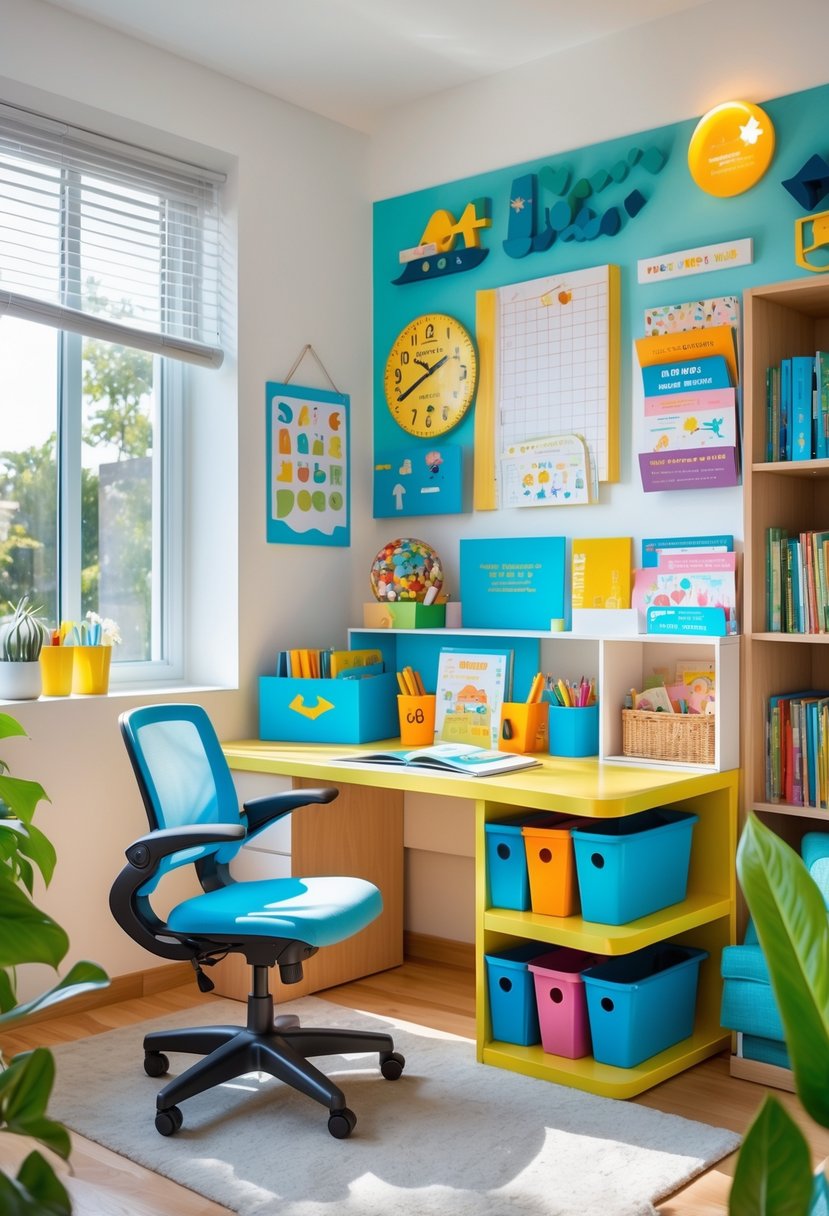Back-to-School Kids Room Makeover Ideas: 12 Practical Tips for a Functional and Stylish Space
Getting a child’s room ready for back-to-school involves more than just packing bags and sharpening pencils. The space where a child studies and rests plays an important role in supporting their focus, creativity, and relaxation. A well-planned room makeover can help create a balanced environment that meets these needs.

A back-to-school kids room makeover prepares a functional and inviting space that encourages organization, comfort, and a positive mindset for learning. This process often includes thoughtful choices to blend style with practicality, making the room suitable for both study and play.
1) Create distinct zones for study, play, and rest to enhance focus and relaxation

They should divide the room into clear areas for different activities. A study zone with a desk and good lighting helps concentration.
A play area can be separate with toys and soft seating. This allows kids to switch easily between work and fun.
The rest zone should be quiet and cozy, with a bed or reading nook. This space supports relaxation and recharging after busy days.
2) Use adjustable desk and ergonomic chair to support proper posture

An adjustable desk lets kids set the right height to keep their elbows at a 90-degree angle. This prevents strain on their arms and shoulders while studying.
An ergonomic chair with lumbar support helps maintain the natural curve of the spine. It should have adjustable seat height and backrest to fit the child’s body.
Feet should rest flat on the floor or on a footrest to reduce pressure on the legs. Proper setup supports good posture and comfort during long study sessions.
3) Incorporate ample storage like colorful bins and shelves for school supplies

He can use colorful bins to sort different school supplies. This helps keep everything easy to find and makes the room look tidy.
Shelves provide space to store books, notebooks, and other items. When they are within reach, it encourages kids to put away their things.
Using labeled bins and stackable containers saves space. It also makes cleaning up faster and keeps supplies from getting lost or mixed up.
4) Apply creative wall paint techniques such as chalkboard paint or geometric patterns

Using chalkboard paint on a wall lets kids write, draw, and erase easily. It creates a fun and functional space for notes and creativity.
Geometric patterns add a modern touch to the room with simple shapes and colors. These patterns can be bold or subtle, depending on the style.
Both options help personalize the room while staying practical for school supplies and art projects.
5) Add whimsical elements like a fairy-tale canopy or jungle-themed wall decals

Adding a fairy-tale canopy can create a cozy and magical space for a child. It helps define a special area for reading or resting.
Jungle-themed wall decals bring nature indoors and add fun to the room. They can inspire imagination and make the space feel lively without too much effort.
Both elements are easy to update as tastes change, making them practical for a growing child’s room.
6) Use multifunctional furniture like loft beds with built-in desks

Loft beds with built-in desks save space by combining sleeping and work areas. This design helps keep the room organized and leaves more floor space for other activities.
They work well for kids who need a quiet place to study without taking up too much room. Many options come in twin or full sizes to fit different needs and spaces.
Using multifunctional furniture like this is a smart way to maximize small rooms while providing both comfort and function.
7) Declutter closets and cabinets to maximize space and organization

They should start by removing items that are no longer needed or used. This frees up space and makes it easier to find what remains.
Next, organizing clothes and supplies by type or frequency of use helps keep things neat. Using bins or shelves can make storage more efficient.
Clear labels or visible containers aid quick access, reducing time spent searching. A tidy closet or cabinet supports a smooth back-to-school routine.
8) Opt for bright, natural lighting with adjustable lamps for homework areas

Natural light helps create a bright and comfortable space for kids to study. Placing homework areas near windows lets them benefit from daylight, which can improve focus.
Adjustable lamps provide direct light on work surfaces. They reduce eye strain and can be positioned to avoid glare or shadows during reading or writing.
Using both natural light and adjustable lamps ensures consistent and clear lighting throughout the day. This setup supports better concentration and a more inviting homework space.
9) Incorporate inspiring educational posters or wall art

Adding educational posters or wall art helps create a motivating space for kids. They can display important facts, positive messages, or colorful images that support learning.
These visuals make the room more lively and can improve focus. Posters with clear, simple designs work best to keep children engaged without overwhelming them.
Choosing themes that match the child’s interests or school subjects encourages curiosity and supports study habits. This kind of decoration makes the space both fun and educational.
10) Use rugs to define areas and add warmth to the room

Rugs help create clear zones in a kids’ room, such as a play area or a study corner. This makes the space feel organized and purposeful.
They also add warmth and comfort, making the floor softer for sitting or playing. Choosing rugs with fun colors or patterns can keep the room lively without being distracting.
Layering rugs or picking textured ones adds depth and a cozy feel that improves the room’s atmosphere.
11) Provide a dedicated space for backpacks and jackets near the door
Creating a spot by the door helps keep backpacks and jackets organized. Wall hooks or over-the-door racks work well for hanging these items.
Adding a small bench with storage underneath offers a place to sit and store shoes or hats.
Using baskets or cubbies nearby can hold smaller items like gloves or school supplies. This setup reduces clutter and makes it easy to grab things on the way out.
12) Include a corkboard or whiteboard for schedules and reminders
A corkboard or whiteboard helps keep schedules and reminders easy to see. It allows kids to pin notes, homework, or important dates all in one place.
They can use the whiteboard for writing daily tasks or drawing quick reminders. This keeps the room organized and aids time management.
Adding these boards creates a clear space for family communication. It also reduces clutter by keeping notes off surfaces like desks or the fridge.
Foundations of a Functional Kids Room
A functional kids room balances organization, safety, and comfort. It creates a clear layout that supports activities like studying, playing, and sleeping. Choosing durable and safe materials ensures the space lasts through daily use and active play.
Space Planning Essentials
Effective space planning starts with defining zones for different activities: study, play, and rest. Each zone needs enough room to avoid clutter and distractions. A compact desk with storage nearby keeps school supplies organized and accessible.
Furniture should be scaled to the child’s size for comfort and ease of use. Multi-purpose pieces like beds with drawers or shelves optimize floor space. Bright, natural light helps maintain focus in the study area, while cozy lighting sets a relaxing mood in the sleeping zone.
Storage is key to keeping the room tidy. Use bins, shelves, and hooks to store toys, books, and clothes. Labeling storage containers can encourage children to clean up independently.
Safety and Durability Considerations
Furniture and decor should be sturdy and built for wear. Rounded edges on desks and beds reduce the risk of injury. Anchoring heavy furniture to the wall prevents tipping accidents.
Materials must be non-toxic and easy to clean. Choosing fabrics that resist stains helps maintain hygiene. Electrical outlets should have safety covers or be placed out of reach to protect younger children.
Floors should have soft rugs or mats to cushion falls. Avoid clutter on pathways to prevent trips. A well-ventilated room with good air quality supports health and comfort during long hours spent indoors.
Supporting Productive Back-to-School Environments
Creating a room where kids can focus and feel comfortable helps them work better and enjoy their space. Attention to colors and lighting plays a key role in shaping how well children concentrate and engage in activities.
Color Psychology and Focus
Colors affect a child’s mood and ability to focus. Blue and green are calming colors that can help reduce stress and improve attention during study time. These shades work well on walls or in decor items like rugs and curtains.
Bright colors like yellow and orange stimulate energy and creativity but should be used sparingly. Accent pieces such as pillows or desk organizers in these colors add interest without distraction.
Neutral tones like white, beige, or gray create a clean, balanced backdrop. Mixing soft colors with bright accents helps maintain a productive yet inviting atmosphere. It’s important to avoid overly bold or dark colors that may cause agitation or fatigue.
Lighting Tips for Study and Play
Good lighting supports both learning and playing. Natural light is best, so placing the desk near a window helps keep the room bright and fresh.
When natural light is limited, use a combination of overhead lighting and task lamps. A bright, adjustable desk lamp with warm light reduces eye strain during homework.
Avoid harsh fluorescent bulbs as they can cause headaches or discomfort. Dimmer switches allow control over the room’s brightness, making it easier to switch between focused work and relaxing play.
Soft ambient lighting in the evening supports winding down without disrupting sleep schedules. Adjustable lighting tailored to different activities promotes comfort and concentration.
Frequently Asked Questions
Many key details go into a successful kids’ room makeover. Practical storage, a well-designed study space, current decor trends, space-saving methods, essential furniture, and color choices all play important roles.
What are some creative storage solutions for a kid’s bedroom?
Using colorful bins helps keep school supplies organized and easy to find. Shelves mounted on the wall provide extra space without crowding the floor. Adjustable storage units can grow with the child, adapting to changing needs.
How can I incorporate a study area into my child’s room design?
Creating a clear zone for studying separates work from play. An adjustable desk paired with an ergonomic chair supports good posture. Adding task lighting and minimizing distractions help improve focus during homework time.
What are the latest trends in tween bedroom decor?
Geometric patterns and chalkboard paint on walls allow kids to express creativity. Whimsical elements like fairy-tale canopies or jungle-themed wall decals add personality. Rooms are designed to balance function with playful style that can evolve as the child grows.
How can I maximize space in a shared kids’ room effectively?
Defining separate zones for each child’s bed, study area, and play space helps reduce clutter. Vertical storage, like tall bookshelves or hanging organizers, frees up floor space. Using furniture with built-in storage keeps the room tidy.
What are some key furniture pieces for a functional and stylish kids’ room?
A sturdy, adjustable desk is essential for a study zone. An ergonomic chair protects posture. Beds with storage drawers underneath combine rest and organization. Multi-purpose furniture like a butterfly chair adds comfort and style.
What tips can you offer for choosing a color scheme for a child’s room makeover?
Opt for colors that inspire calm and creativity, such as soft blues or greens. Accent walls with chalkboard paint can make the space interactive. Geometric patterns add interest without overwhelming the room. Balance bright and neutral tones for a welcoming feel.

